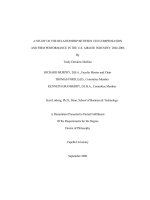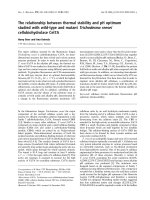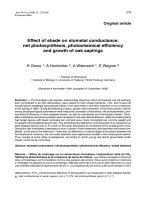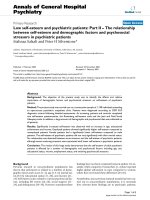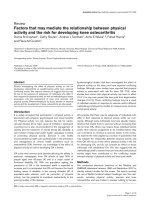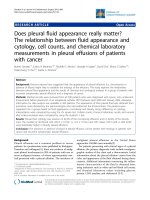the moderator effect of organizational identification on the relationship between work context and workforce engagement burnout
Bạn đang xem bản rút gọn của tài liệu. Xem và tải ngay bản đầy đủ của tài liệu tại đây (662.88 KB, 87 trang )
The Moderator effect of Organizational Identification on the relationship between Work
Context and Workforce Engagement/Burnout.
THESIS
Presented in Partial Fulfillment of the Requirements for the Degree Master of Labor and
Human Resources in the Graduate School of The Ohio State University
By
Cristiano Levi Oseliero Guarana
Graduate Program in Labor and Human Resources
The Ohio State University
2010
Master's Examination Committee:
Robert L. Heneman, Advisor
David B. Greenberger
Steffanie Wilk
Copyright by
Cristiano Levi Oseliero Guarana
2010
ii
Abstract
This thesis examines the extent to which organizational identification modifies the
relationship between some job demands and resources (workload, feedback, supervisory
support and organizational support) and workforce engagement level. This study also
explores the impact of organizational identification on the relationship between the same
job demands and resources (workload, feedback, supervisory support and organizational
support) and the workforce burnout level.
By examining these moderating factors, I clarify how factors other than the
relationship between the employee and the job, employee and the supervisors, and
employee and the organization influence workforce engagement and burnout levels.
Thus, this research proposes an extended analysis to comprehend workforce engagement
and burnout by presenting their definitions, how they are correlated and what are their
antecedents (job demands and resources).
Furthermore, current research indicates that these moderator effects are
appropriate. First, highly identified individuals tend to support institutions embodying
those identities which may lead to high levels of dedication and absorption - two
components of engagement. Second, highly identified individuals are knowledgeable of
their membership and express emotional attachment to that membership, which can be
iii
compared to three psychological conditions to evaluate engagement level:
meaningfulness, safety and availability. Third, social identities and organizational
identification are ―relational and comparative‖ which may alter the impact of job
demands on burnout, since employees may evaluate the demands as a source of
differentiation.
A questionnaire was administered to employees in 3 different companies with
different sizes (small, medium and large – total N = 122), different economic sectors
(auto-parts, technology and communication and agriculture), and a five step hierarchical
multiple regression analyses conducted to detect main interaction effects.
The results revealed that organizational identification modifies the relationship
between all job demands and resources included in this model, and engagement. The
engagement level of low identified employees is more sensitive to different levels of
resources and demands. In contrast, employees with high levels of organizational
identification demonstrated higher levels of workforce engagement even when the
workload was high and feedback, supervisor support and organizational support were
low. Interestingly, the engagement level of highly identified employees was lower when
they were exposed to low workload, high feedback and high supervisor support.
Finally, the impact on burnout was present only in its relationship with workload.
High levels of organizational identification minimized the impact of high levels of
workload on burnout.
iv
Dedication
This thesis is dedicated to my wife who has been a great source of motivation and
inspiration. She has shared all difficult moments that I faced during this long journey.
Also, this thesis is dedicated to my parents who have supported me all the way
since the beginning of my studies.
Finally, this thesis is dedicated to all those who believe in the richness of learning.
v
Acknowledgments
I would like to thank all people who have helped and inspired me during my
graduate studies.
I especially want to thank my advisor, Dr. Robert Heneman, for his guidance
during my research and study at Ohio State University. His perpetual energy and
enthusiasm in research had motivated me. In addition, he was always accessible and
willing to assist me with my research. As a result, research life became smooth and
rewarding for me.
I was delighted to interact with Dr. Steffanie Wilk by attending her classes and
having her as my co-advisor. Her insights into workforce engagement and organizational
identification were critical to the completion of my research. For me, she set the standard
for world-class research with her rigor and passion for her work.
Dr. David B. Greenberger also deserves special thanks as my thesis committee
member and advisors. In particular, I would like to thank Dr. Greenberger for guiding me
through the technical avenues of this research.
All my classmates at the Fisher College of Business made it a convivial place to
study. In particular, I would like to thank Katie Stevenson for her friendship and help in
the past two years. All other folks, including Megan Heighton, Allison Abrahams, Lauren
vi
Griffith, Caterinna Sampe and Desmond Sumiya, had inspired me in research and life
through our interactions during the long hours in the class. Thank you.
vii
Vita
2000 B.S. Economy, Inst. Toledo de Ensino
2002 M.B.A., Ohio University
2008 to present M.L.H.R., The Ohio State University
Fields of Study
Major Field: Labor and Human Resouces
viii
Table of Contents
Abstract ii
Acknowledgments v
Vita vii
List of Tables x
List of Figures xi
Introduction 1
Chapter 1: Engagement and Burnout 3
Chapter 2: Antecedents of Engagement and Burnout 7
Chapter 3: Organizational Identification 13
Chapter 4: The research model 16
Chapter 5: Hypothesis 19
Chapter 6: Design and Method 27
Measurement 28
Analysis 30
Chapter 7: Results 32
ix
Chapter 8: Discussion 48
Chapter 9: Practical Implications 57
Chapter 10: Limitations and Future research 60
Conclusions 64
References 66
Appendix A: Scales 71
x
List of Tables
Table 1 – Means, Standard Deviation and Correlations 32
Table 2 – Hierarchical Regression Analyses – Dependent Variable: Engagement 34
Table 3 - Hierarchical Regression Analyses – Dependent Variable: Burnout 36
Table 4 - Interaction effects – Dependent Variable: Engagement 39
Table 5- Interaction effects – Dependent Variable: Burnout 40
xi
List of Figures
Figure 1 – Research Model 16
Figure 2 - Interactive effect of organization identification and workload on workforce
engagement and burnout. 42
Figure 3 - Interactive effect of organization identification and feedback on workforce
engagement 44
Figure 4 - Interactive effect of organization identification and supervisor support on
workforce engagement. 46
Figure 5 - Interactive effect of organization identification and organizational support on
workforce engagement. 47
1
Introduction
During the past three decades, many studies have shown that work context can
have a profound impact on employee well being, individual performance and
organizational success. Past research revealed that job demands such as workload and
role ambiguity may lead to exhaustion and impaired health (e.g. Doi, 2005; Halbesleben
and Buckley, 2004), whereas job resources such as supervisor support, performance
feedback, and organizational support may a motivational process leading to job-related
learning and organizational commitment (Demerouti et al., 2001; Taris and Feij, 2004).
This research focuses on two constructs that are influenced by job resources and
demands: workforce engagement and burnout (Schaufeli, 2002 and Salanova et al.,
2005). However, due to their individual perceptive natures (Kahn, 1990; Maslach et al
2001), workforce engagement and burnout may be affected by an individual‘s cognitive
and evaluative skills that are beyond the scope of job resources and demands. For
example, though engagement requires individual evaluations of the job resources
available (Kahn, 1990), the individual may possess adequate job resources but may not
perceive them as useful or sufficient. Thus, organizational identification, and its required
sense of attachment, belongness, and membership, has the potential to modify the
relationship between job demands and resources, as well as workforce engagement and
2
burnout, since it will affect how individuals will internalize the perception of those job
resources and demands.
The purpose of this study is to investigate how organizational identification
modifies the relationship between some job demands and resources such as workload,
feedback, supervisory support and organizational support, and workforce engagement
level. Moreover, this study also explores the impact of organizational identification on
the relationship between the same job demands and resources and workforce burnout
level.
This thesis expanded previous research in the field in two ways. First, while
previous research on organizational identification has focused primarily on identification
definition and its impact on the organization performance (Tajfel, 1978; Brewer &
Gardner, 1996; Turner, Oakes, Haslam, & McGarty, 1994; Elsbach, 1999; Corley et al.,
2006; Cole & Bruch, 2006; Kreiner & Ashforth, 2004), this study focused on the
moderator effect of organizational identification in particular. Second, previous
engagement and burnout theory has focused on the relationship between the employee
and the job, the employee and the supervisors, and the employee and the organization as
antecedents of engagement and burnout (Kahn, 1990; Schaufeli, 2002). For example,
Kahn (1990) evaluates how task characteristics, role characteristics, work interactions,
interpersonal relationships group dynamics, management style and organizational norms
affect engagement. This study took a different approach and focused on how
organizational identification modifies the relationships between job resources and
demands, and engagement and burnout.
3
Chapter 1: Engagement and Burnout
The key differentiator of competitive advantage in the new world economy is the
organization‘s employees (Minervini, Meyer & Rourke, 2003). However, employees
have to cope with increasing demands from various and diverse roles and organizational
stakeholders, often with limited resources (Minervini et al., 2003). Moreover, monitoring
and improving employee effectiveness in coping with multiple new demands, stimulating
their growth and enhancing their wellbeing as well as their organizational performance
are current challenges of any organization. In this regard, engagement and burnout are
specific research areas (Maslach et al., 2001).
The notion of employee engagement is relatively new (Macey & Schneider,
2008). Kahn (1990) was the pioneer in the field to first define the construct, however,
after that, numerous different interpretations have been made, generating some
misleading conclusions. At a minimum, the question remains as to whether engagement
is a unique concept or merely a repackaging of other constructs (Lubinski, 2004). Thus,
in order to avoid misinterpretations in this research while the engagement construct
evolves, a clear definition is required.
Kahn (1990) stated that engaged people employ and express themselves
physically, cognitively, and emotionally during role performances. His research premise
4
was twofold: first, that the psychological experience of work drives people's attitudes and
behaviors (Hackman & Oldham, 1980); second, that individual, interpersonal, group,
intergroup, and organizational factors simultaneously influence these experiences
(Alderfer, 1985). He assumed that those work contexts, mediated by people's perceptions,
created the conditions in which employees personally engage. Besides, he defined three
psychological conditions to evaluate engagement level: meaningfulness, safety and
availability. People vary their personal level of engagement according to their perceptions
of the benefits - described as meaningfulness - and the guarantees - described as safety -
they perceive in situations. Finally, engagement also varies according to the resources
they perceive themselves to have - which Kahn (1990) termed availability.
More recent research performed by Schaufeli et al. (2002) describes engagement
―as a positive, fulfilling, work-related state of mind that is characterized by vigor,
dedication, and absorption.‖ They further state that engagement is not a momentary or
specific state, but rather, it is ―a more persistent and pervasive affective-cognitive state
that is not focused on any particular object, event, individual, or behavior.‖ In order to
further delineate the construct, Schaufeli et al. (2002) stated that vigor is characterized by
high levels of energy and mental resilience while working, the willingness to invest effort
in one's work, and persistence also in the face of difficulties. Dedication is characterized
by a sense of significance, enthusiasm, inspiration, pride, and challenge. Absorption is
characterized by being fully concentrated and happily engrossed in one's work, whereby
time passes quickly and one has difficulties with detaching oneself from work. In the
present study, the Schaufeli et al (2002) engagement definition and proposed scale will be
5
used to measure different levels of workforce engagement however the subcategories
(vigor, dedication and absorption) will not be evaluated independently.
Although burnout was originally conceptualized in the context of the helping
professions (Rothmann, 2002), it has recently expanded to all types of professions and
occupational groups. Burnout was studied as the individual‘s relational transactions in the
workplace. This interpersonal context focused attention on the individual‘s emotions, and
on the motives and values underlying his or her work with recipients (Maslach et al,
2001). Burnout is thought to be comprised of three interrelated components—emotional
exhaustion, depersonalization (cynicism), and diminished personal accomplishments
(professional efficacy) (e.g., Maslach and Jackson 1981).
The emotional exhaustion component of burnout occurs as a response to job-
related demand stressors placed on employees, thus, it represents the basic individual
stress dimension of burnout (Maslach and Jackson, 1981). Depersonalization (Bakker and
Shaufeli, 2004) or cynicism, is a dysfunctional response to work-related stress resulting
from the perception that important aspects of a job are random or uncontrollable. It
represents the interpersonal context dimension of burnout. Diminished personal
accomplishment (Bakker and Shaufeli, 2004) or professional inefficacy refers to a decline
in an employee‘s feelings of competence and successful achievement on the job.
Representing the self-evaluation dimension of burnout, diminished personal
accomplishment stems from factors suggesting one is ineffective or unappreciated.
According to Maslach et al. (2001), the study of work context should include the
entire continuum of work-related experiences, ranging from negative (burnout) to
6
positive (work engagement). Therefore, this research will consider both constructs,
although, I will measure them with different instruments given that they are independent
constructs that are, indeed, moderately or strongly negatively related (Schaufeli, 2002).
7
Chapter 2: Antecedents of Engagement and Burnout
The workforce engagement and burnout researchers have already demonstrated
that job resources and demands are relevant antecedents of engagement and burnout
(Maslach, 1981; Schaufeli, 2002; Bakker, 2007; Cropanzano, 2005). Thus, generally
speaking the work context of workforce engagement and burnout can be divided into two
categories: job resource and job demand (Schaufeli, 2002). Job resources refer to those
physical, psychological, social, or organizational aspects of the job that either/or (1)
reduce job demands and the associated physiological and psychological costs; (2) are
functional in achieving work goals; (3) stimulate personal growth, learning and
development (Schaufeli, 2002). Bakker et al. (2001) found that job resources were
predictors of engagement. Recently, Salanova and Schaufeli (2008) concluded that the
absence of job resources fosters disengagement, whereas the presence of job resources
stimulates personal development and increases work engagement.
Jones and Fletcher (1996, p. 34) define demands as "the degree to which the
environment contains stimuli that peremptorily require attention and response. Demands
are the 'things that have to be done.‖ Clearly, in every job something has to be done.
More specifically, I refer to job demands as those physical, psychological, social, or
organizational aspects of the job that require sustained physical and/or psychological (i,e
8
cognitive or emotional) effort and are therefore associated with certain physiological
and/or psychological costs. Although job demands are not necessarily negative, they may
turn into job stressors when meeting those demands requires high effort that elicits
negative responses such as depression, anxiety, or burnout.
Since each level of the work context captures specific impacts on engagement and
burnout (Kahn, 1990; Maslach, 1981; Schaufeli, 2002), the current model includes: task-
level, interpersonal level and organizational level.
The task-level, in this thesis represented by workload, was introduced to capture
the impact of work itself on the individual reaction. Schaufeli (2002) demonstrated that
workload is related to low levels of engagement and high levels of burnout. However, I
assume that some tasks, and their respective amount, can affect individuals differently
based on the attachment that he/she has to the organization. Individuals with high levels
of organizational identification may demonstrate different reactions to different levels of
workload representing different levels of engagement and burnout.
Interpersonal level, measured here as feedback and supervisor support, represents
the relational network inherent to the required psychological safety present in the
engagement construct, and depersonalization - a characteristic of the burnout concept.
Schaufeli (2002) demonstrated that feedback and supervisory support are predictors of
the subcomponents of engagement and burnout which ultimately lead to different levels
of engagement and burnout. My focus, however, is to evaluate if organizational
identification moderates the relationship between such job resources and engagement and
burnout.
9
The organizational level, represented in this thesis by organizational support,
evaluates how the workforce perceives the organization as a unique entity composed of
strong supportive relationships which facilitate internalization of organizational values.
Sacks (2006) confirmed that organizational support is critical to high levels of
engagement which is in accordance with Kahn‘s (1990) findings. Both researchers
demonstrated that organizational support was positively related to psychological safety,
one of the subcategories of engagement (Kahn, 1990). Moreover, Maslach (2001)
demonstrated that lack of organizational and social support is related to burnout. In this
thesis, I verify if organizational identification modifies the impact of organizational
support on engagement and burnout levels. Such theory support will be provided later.
Workload has been studied by many burnout researchers, and the findings support
the general notion that burnout is a response to high levels of work demand (Maslach et
al, 2001). Perrewe and Ganster (1989) defined high levels of workload as the amount of
work that exceeds what an individual can accomplish in a given period of time. Workload
that is overwhelming because it exceeds the skills, knowledge, and abilities of individuals
is referred to as qualitative work overload. At the same time, if the workload negatively
influences the quantity and quality of the work delivered, the employee can express
feelings of exhaustion (Lee and Ashforth, 1996) which may lead to a complete burnout.
On the other hand, if the work in its composition and amount is consistent with
the employee‘s skill, knowledge, and abilities (Hobfoll, 2001), it will, most likely foster
workforce engagement. Employees will become fully concentrated, inspired and
10
challenged because they cognitively or emotionally evaluate themselves as having the
right physical, psychological, and emotional ―tools‖ to perform the job.
Bakker and Demerouti (2007) found that proper feedback fosters learning,
thereby increasing job competence, whereas decision latitude and social support satisfy
the need for autonomy and the need to belong, respectively. Specifically, performance
feedback which promotes objective information about individual performance fosters
extra effort, persistence and resistance—characteristics described in the engagement
construct as vigor, absorption and dedication. Moreover, proper feedback helps the
employee understand what is expected, what should be learned and how to improve the
current performance, which can lead to states of engagement (psychological
meaningfulness), and social systems that create less threatening, predictable social
situations in which to engage (psychological safety).
The lack of feedback may promote burnout by increasing the cynicism level and
reinforcing feelings of ineffectiveness for the same reasons. Employees will face feelings
of self-inefficacy because they may not understand what is required to improve the
current performance which can create cynicism and detachment from the job. Finally,
Maslach (2001) stated that lack of feedback is consistently related to all three dimensions
of burnout.
Supervisor support can be defined as the degree to which supervisors value
subordinate contributions and care about subordinate well-being (Kottke and Sharafinski
1988). Later, Schaufeli and Bakker (2004) stated that engagement and burnout are
indicators of employee wellness. Moreover, Heijden (2001) stated that good supervisory
11
feedback enhances the opportunity for advancement in worker capabilities resulting in
social recognition and growth potential. Finally, Dirk and Ferrin (2002) advocate that a
high degree of supervisor support would elicit employee trust in supervisors, which might
raise employee job satisfaction.
Such definitions may be compared to at least one of the engagement
characteristics: psychological safety. According to Kahn (1990) people felt safe in
situations in which they trusted that they would not suffer for their personal engagement.
Thus, interpersonal relationships promoted psychological safety when they were
supportive and trusting, and generated further career development (Kahn, 1990).
According to Kahn, if an employee perceives positive supervisory support, he or she will
invest more effort and persist when facing a difficult situation by releasing more energy
and demonstrating vigor. On the other hand, when supervisors are abusive behavior, they
damage the associability and trust level with the employees, eroding psychological safety
and engagement.
Organizational support is defined as an employee‘s perception of the concern an
organization shows for his or her well-being. Research has shown that perceived
organizational support is positively related to conscientiousness in carrying out job
responsibilities, commitment and innovation (Eisenberger et al., 1990). A large body of
evidence indicates that employees with high levels of Perceived Organizational Support
(POS) judge their jobs more favorably—demonstrating increased job satisfaction, more
positive mood and reduced stress. Employees with high levels of POS are more invested
12
in their organization in that they have increased affective organizational commitment,
increased performance and reduced turnover (Rhoades and Eisenberger 2002).
Conscientiousness in carrying out job responsibilities is related to the vigor
component of the engagement construct since vigor is described as energy, effort and
persistence. Moreover, dedication and absorption can be related to the POS theory when
employees perceived themselves as ―more invested in their organization‖ demonstrating
enthusiasm, inspiration, pride and happiness. Lack of organizational support can foster
burnout by creating inadequate conditions to meet significant and ongoing demands
confronted by the worker, which leads to a downward spiral in energy loss (Hobfoll,
1998).
In summary, different job resources and job demands may have distinct effects on
workforce engagement and burnout. Moreover, the job contexts studied in this model
(workload, feedback, supervisor support, and organizational support) represent different
levels of the work relationship which is required to comprehend broadly how
organizational identification influences the engagement and burnout levels.
13
Chapter 3: Organizational Identification
In order to better understand organizational identification, a brief review of social
identity and identification may be required as the organizational identification construct
derives from social identity and identification. Tajfel (1978: 63) defined social identity as
―that part of an individual‘s self-concept which derives from his/her knowledge of his
membership of a social group (or groups) together with the value and emotional
significance attached to that membership.‖ Tajfel and Turner (1986: 16) added that social
identities are ―relational and comparative,‖ as group members gain both a descriptive
sense of their identity (who are we?) and an evaluative sense (how good are we?) by
contrasting the ingroup with a salient outgroup(s).
Individuals occupy multiple roles, and identity theory is concerned with how the
social embeddedness of roles in valued relational networks increases their likelihood of
being activated and performed well in a given situation (Ashforth et al, 2008). The more
valued the relationship, the more important the role identity and the more likely the
person will strive to affirm the identity (Burke & Reitzes, 1991). Finally, identity is the
central, distinctive, and enduring characteristic of an organization: it is how the collective
answers the question ―who are we as an organization? (Albert & Whetten, 1985).
